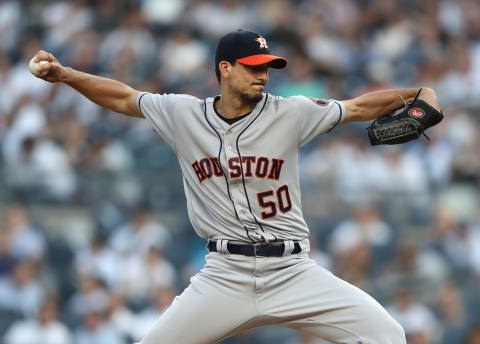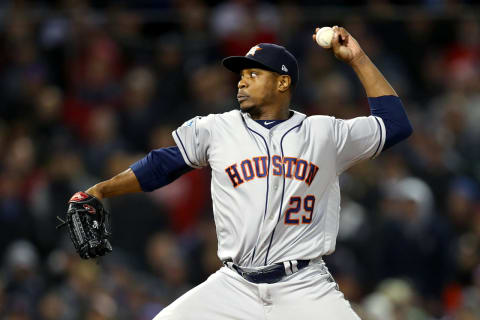Astros: Best, worst free agent signings of past decade

With the 2010s coming to a close, here’s a look at the Astros best and worst free agent signings of the decade.
The end of a decade is a great time to stop and look back at all that happened over the last 10 years. The Astros have played some of the best baseball the game has ever seen, and also some of the worst. It’s been a roller coaster decade for this club.
We recently went back and looked at the best and worst trades the Astros made in the 2010s, so now we turn our attention to free agency. The club was not a major player in free agency for most of this decade, preferring to build through the draft and via trades.
In fact, the largest free agent contract the Astros gave out was the four-year, $52 million deal with Josh Reddick prior to the 2017 season. That one doesn’t make either of our best or worst lists, as they got great production from Reddick in 2017 and he’s been a serviceable everyday player in the two years since. A decent deal, but nothing to write home about.
For the most part, the Astros looked to find buy-low options with minimal risk involved, taking chances on several veterans looking to rebound. Even in the many such instances when the player did not perform well, the club wasn’t stuck with a bad contract or paying a lot of money for an underperforming guy, so it’s hard to classify them as bad signings.
With that in mind, here are the best and worst Astros free agent deals of the decade.

Best: Astros sign Charlie Morton to a two-year, $14 million deal (Nov. 16, 2016)
This was a pretty easy choice. No one really expected much when the Astros brought in the veteran journeyman Morton. It was thought he would simply eat up some innings at the back end of the rotation. He had just turned 33 and only made four starts in the previous season due to injury.
Well, the Astros helped him change his approach and redefine himself as a pitcher. He ditched the sinker for a four-seam fastball that reached the upper 90s and suddenly became a force. He went 14-7 with a 3.62 ERA in 25 starts that first season and was on the mound for the final out of the Astros’ 2017 World Series championship.
Morton was even better in 2018, leading the majors in winning percentage and going 15-3 with a 3.13 ERA in 30 starts, striking out 201 batters. All told, he put up a 3.36 ERA in 55 regular season starts with the Astros, making that contract look like an absolute steal.
Unfortunately the club did not re-sign him after that 2018 season and he ended up in Tampa where he was even better, finishing third in the Cy Young Award voting. He made more money with the Rays in 2019 than he did over the life of his two-year deal with Houston.
Honorable Mentions
So far, the Michael Brantley signing has turned out quite well. The Astros inked him to a two-year, $32 million deal prior to the 2019 season and he cemented himself as a reliable veteran bat in the middle of the lineup. The 32-year-old hit .311/.372/.503 with 40 doubles, 22 homers and 90 RBIs and earned his fourth career All-Star selection.
Despite the fact that his season ended poorly, the Wade Miley signing was still an excellent move by the Astros. He made 33 starts and went 14-6 with a 3.98 ERA, providing stability in the middle of the rotation at a reasonable $4.5 million price for one year.
The club brought in Colby Rasmus on a one-year, $8 million deal prior to the 2015 season and he rewarded them with a .238/.314/.475 line and 25 homers. He accepted the club’s qualifying offer after the season and had a poor 2016 while making $15.8 million, but the initial one-year deal the Astros gave him was money well spent.
Some more money well spent was the one-year, $5.75 million deal given to Robinson Chirinos for 2019. He provided above-average offensive production and caught all of Justin Verlander’s innings. Though he’s likely going to play elsewhere next year, that’s a deal the club would make again.
Finally, we would be remiss if we didn’t mention Yuli Gurriel, who’s making $47.5 million on a five-year deal. He was an amateur free agent, but this was much different than your typical amateur free agent signing. He’s turned in a .293/.330/.478 line in four seasons and put up his best year yet in 2019 with 40 doubles, 31 homers and 104 RBIs, also finishing as a Gold Glove finalist.

Worst: Astros sign Tony Sipp to a three-year, $18 million deal (Dec. 11, 2015)
In truth, this is the only candidate I could come up with for this distinction, as all of the other deals that didn’t work out were low-risk one-year pacts. That was not the case for Sipp, however, and the Astros ended up stuck with him.
Sipp put up an excellent 2015 season in Houston, pitching to a 1.99 ERA in 60 appearances. He’d put up a 3.38 ERA in 56 appearances the year prior, so he gave the club reason to feel confident in him. They were confident enough to give him $6 million a year for three years.
More from Climbing Tal's Hill
- Just how much better is the Houston Astros playoff rotation than the rest?
- Houston Astros: A Lineup Change to Spark Offense
- Astros prospect Hunter Brown throws 6 shutout innings in debut
- Always faithful Astros World Series champion Josh Reddick defends the title
- Michael Conforto declines Astros’ 2-year, $30 million offer
The first two years of that deal were pure disasters. Sipp compiled a 4.95 ERA in 2016, seeing a huge spike in his hit and home run rates to the tune of a 1.603 WHIP. Most of his numbers were a little better in 2017, with one exception — his ERA rose to 5.79. He did not pitch at all in the postseason during the team’s championship run.
He was markedly better in 2018, pitching to a 1.86 ERA in 54 appearances. However, he’d already lost manager AJ Hinch‘s trust and was not used in many important or high-leverage situations. He made three appearances in the ALCS against Boston, allowing three of seven hitters to reach base.
So that deal was a bust, but it says a lot about a front office when the worst free agent contract you’ve given out is for a total of $18 million. You have teams like the Angels and Yankees who pay enormous sums to way-past-their-prime veterans, but the Astros have successfully avoided those albatrosses.